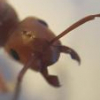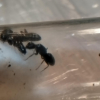There are 7 Formica species groups in North America, fusca, pallidefulva, neogagates, sanguinea, rufa, microgyna, and exsecta. Learning to distinguish between the different species groups can take some practice, but I can help get you started.
First off is the Formica fusca-group. Ants in the Formica fusca-group can be fairly easily distinguished from other species groups by the presence of at least some appressed, silvery pubescence. Most species are black or brownish, though certain species can be bicolored reddish-brown and black. The Formica fusca-group used to be classified as its own subfamily, Serviformica. This species group contains the following species (Francoeur, 1973):
subpolita
francoeuri
altipetens
montana
canadensis
pulla
occulata
propatula
neoclara
hewitti
neorufibarbis
subcynea
lepida
pachucana
transmontanis
longipilosa
aerata
pacifica
argentea
subsericea
glacialis
podzolica
microphthalma
accreta
sibylla
subelongata
browni
retecta
foreliana
gnava
xerophila
Ants of the Formica pallidefulva-group are sleek, leggy Formica with unique color variations. Four of the five known species (short of F. archboldi) have two distinct color variations, with some mixing involved, a bright yellow color phase in the south and a deep brown, almost black color phase in the north. These ants have a very shiny cuticle, with little to no pubescence present. The species group was previously classified under the subgenus Neoformica. This species group contains the following species (Trager, MacGown, & Trager, 2007):
pallidefulva
dolosa
archboldi
incerta
biophilica
The Formica neogagates-group can be difficult to distinguish from the Formica pallidefulva-group, and the species groups may need to be told apart by looking at individual species. They are smaller than most Formica, and are typically brown and shiny (Fisher & Cover, 2007). This species group contains the following species:
bradleyi
lasiodes
limata
manni
neogagates
obtusopilosa
oregonensis
perpilosa
vinculans
Sanguinea group Formica are slave-raiders. They are easily distinguished by a "median concave impression on the anterior border of the clypeus (Fisher & Cover, 2007)." Previously classified under the subgenus Raptiformica, the Formica sanguinea species group contains the following species:
aserva
creightoni
curiosa
emeryi
gynocrates
pergandei
peberula
rubicunda
subintegra
wheeleri
Ants in the Formica rufa-group are commonly referred to as "wood ants", and includes the famous European Formica rufa. As the taxonomy of this species group is currently a mess (Fisher & Cover, 2007), there is no real distinguishing feature of this species group, apart from their ecological habits of building thatch mounds and being temporary social parasites, features shared with a few other Formica species group. This species group contains the following species (Stockan, Robinson, Trager, Yao & Yeifert, 2016):
reflexa
dakotensis
paralugubris
oreas
obscuriventris
laeviceps
fossaceps
coloradensis
obscuripes
planipilis
subnitens
ravida
integra
ciliata
mucescens
comata
criniventris
prociliata
ferocula
calviceps
propinqua
integroides
The Formica microgyna-group is characterized by their tiny queens, as small as or smaller than the largest workers (Cover & Fisher, 2007). This unique species group contains the following species:
adamsi
densiventris
difficilis
impexa
indianensis
microgyne
morsei
nepticula
nevadensis
postoculata
querquetulata
scitula
spatulata
talbotae
Finally, the Formica exsecta species group. This species group can be easily recognized by the strongly concave posterior border of the head (Cover & Fisher, 2007). This species group only contains three North American species, those species being:
exsectoides
ulkei
opaciventris
I hope you and anyone else who reads this finds it helpful. Just know, I am by no means qualified to be talking about Formica in such detail, and if there is anyone more qualified than I am who would like to add on to this, I welcome it.




















